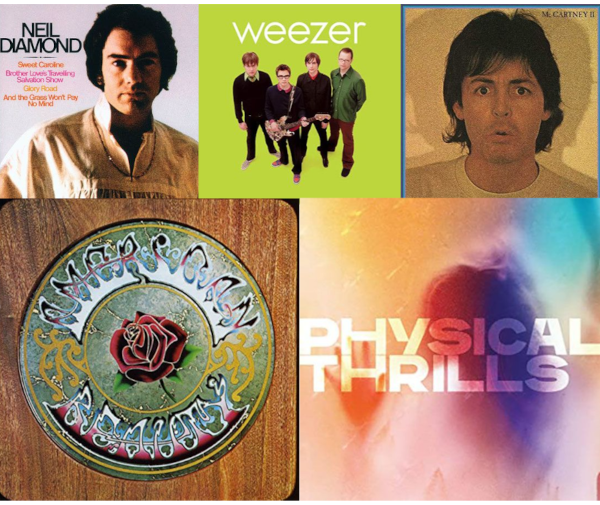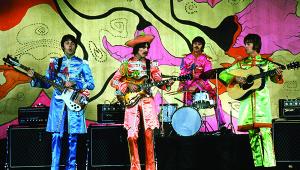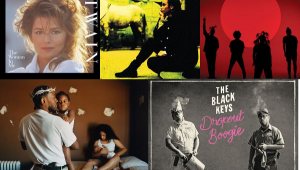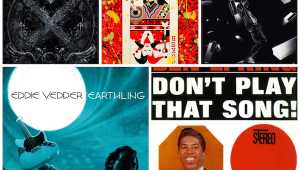Spatial Audio Never Seemed So Good

Where oh where did the month of August go? For many of us, this final home stretch of summer went by with time spent on the beach, in the park, at a resort, attending family gatherings, and/or at concert and sporting events. Or, if you’re like me, much of your summertime was spent in your listening room, catching up on the very best in vinyl, digital, and surround sound offerings both new and old. (I swear, I swear—I also spent a decent amount of quality time outside as well, but thanks for your concern.)
At any rate, as August comes to a close, it’s time for the first monthly installment of our ongoing Spatial Audio File column. As always, I’ve thoroughly spec’ed and checked all five tracks I’ve selected here by way of my personal deep-dive listening sessions on both my home system and headphones alike. You’ll find each and every one of them amidst the cavalcade of Made for Spatial Audio and Dolby Atmos tracks within the ever-expanding Apple Music library.
With the fall season seemingly right around the corner, let’s take one more summer spin together and check out this month’s fine quartet of truly immersive tracks, which are. . .

PAUL McCARTNEY: “TEMPORARY SECRETARY”
The once and forever Beatle Paul McCartney ultimately evolved into a solo artist of A-level caliber, not long after The Fab Four called it quits in 1970. A trio of his roman-numeraled solo albums, each of them released on the decade marker thrice between 1970 and 2020, were each true solo albums in the sense that Paul played every instrument on them (albeit with two minor, asterisked exceptions). While it’s hard to pick just one song, “Temporary Secretary,” a cult-favorite track from the middle child of these three albums, May 1980’s McCartney II, finds its especially electropop-minimalistic form that much more heightened in Dolby Atmos.
“Secretary” opens with a skittery, and somewhat creepy programmed synth line panning across the soundstage from left to right and back, with Macca’s kick-drum and snare nestled just left of center, slightly above the main plane. A lone acoustic-guitar riff jangles ever-so-briefly in the right channel, foreshadowing the melody lines to come, then returns to the same field, this time with a smashing snare behind it.
McCartney’s processed lead vocals enter center-left, with the clearly not-so-innocent request, “Mister Marks can you find for me / Someone strong and sweet fitting on my knee?” (If you end up visualizing Maggie Gyllenhaal and James Spader in the 2002 film
The creepy synth sample continues swirling back and forth across the field, but the guitar jangle has migrated to the far left, albeit slightly processed. “And a temporary secretary is what I need for to do the job,” Macca the protagonist insists, still placed left of center, but now with a doubled vocal whose overall character is somewhat reminiscent of how Phil Collins would also adopt vocal character shifts in certain solo and Genesis story-songs of his in the early/mid-’80s.
Paul assumes a more nasally, pince-nez kind of tone as he begins repeating the title phrase, which echoes off to the left and right, chorally speaking. Listen for the subtle cymbal hit down the middle right after he completes his second run at the title phrase. When he gets to the “she can be a belly dancer” checklist section, Paul’s vocal is more directly centered, and the ensuing cymbal hits take to the center left. As the title phrase again gets repeated almost incessantly, the layers of vocal-doubling, and where they get placed, shuffle a bit each time they’re sung. You’ll also get some right-quadrant cloud-based whoops and squawks in the final 30 seconds of the job search, er, song.
There’s nothing transitory about it—Macca’s “Temporary Secretary” has quickly become a permanent Atmos-ified favorite of mine, and it’s now officially employed as the top song on my Made for Spatial Audio tracklist of the month.
WEEZER: “ISLAND IN THE SUN”
The opening guitar riff commences off to the far right, with a slight reverb in the center, clear enough here in Atmos that you can practically visualize the physical strumming of the chords. When vocalist Rivers Cuomo chimes in with his first center-left “hip-hip,” a thumping kick drum and burbling bass soon enough join in—and yes, this is your official, semi-recurring cue to make sure your sub channel is ready for some beefy low-end activity—before spreading wider across the field. Cuomo’s second and third dual “hip” takes are slightly further back in the mix at this point.
An acoustic, rhythmic guitar joins the fray in the left-center—closer to the left than to the center—and Cuomo begins his reverie, “When you’re on a holiday / You can’t find the words to say,” with his vocals drifting between center-left and dead-center. A counter guitar line appears in the far right on the second verse, and when Cuomo sings the doubled title phrase for the first time, he’s somewhat above the main plane.
The overall sunny vibe of “Islands” should have your head a-bobbing along by this point—something we can somewhat attest to the album’s producer, Ric Ocasek, who knew a thing or two (or three) about creating lanes-full of earworms when he was producing and performing primo new-wave rock tracks with The Cars.
Cuomo’s lead vocals continue to weave around and across the soundstage, perhaps mirroring the position of someone who might be floating in the water around said titular sun-drenched isle. You’ll also note how the semi-reserved guitar noodling in the middle shifts into fuller-volumed, fuzzed-out overdrive up the middle on the bridge before pulling back to jangletown upon the next “hip-hip” recurrence.
It makes me feel so fine to say “Island in the Sun” is a surefire end-of-summer hit in Spatial Audio.
NEIL DIAMOND: “SWEET CAROLINE”
Bass, trumpet, and organ all pull together up the middle at the track’s outset, with timekeeping cymbal taps well off to the left. The trumpet lines, now doubled, nudge just slightly right of center as the intro continues, before Diamond sets the vocal stage with, “Where it began / I can’t begin to knowing,” a grammatically awkward vocalized shoulder-shrug of sorts replete with a slight echo just left of center, before he resumes with the more definitive and assertive, “But then I know it’s growing strong.”
An accompanying guitar line enters over to the right as the second verse gets underway, the hornline wafting around Diamond’s vocals in the ether. As the next verse builds, the drumming and cymbalwork pick up the pace in the left, with string accompaniment now joining in as Diamond extends the vowel in the final “you” before nailing his first crack at the title phrase—with the female background vocals just behind him in the center ether—the ensuing trumpet punctuating the three notes everyone now sings together live at center-right.
The buildup to the next chorus payoff follows, the strings more prominent with their punctuation over to the left. Diamond takes a slight beat between the phrases, “reaching out,” “touching me,” and “touching you,” his signature “vowel-growl,” as I’m calling it, taking on more prominence at this point. A brief instrumental break featuring centered string-plucks and right-leaning trumpet responses hold sway until Diamond returns in the clouds to take it all to the fade.
Atmos never seemed so good before “Sweet Caroline” came along and upped the ante, wouldn’t you agree? (Whoa-oh-oh. . .)
SILVERSUN PICKUPS: “STICKS AND STONES”
Acoustic guitars drive the outset of “Sticks,” spread wide across the stage with minimal drumwork up the middle. You’ll hear fingers moving on the frets (mostly on the left) to signal the chord changes. Nikki Monninger’s ethereal lead vocals enter from on high with the quite apropos, “Heaven sent this little twitch in my eye,” before she swoops slightly downward to the main center.
The acoustic accompaniment remains wide-panned on both sides to give Monninger’s vocals a clear centralized berth. She extends the vowel in “strong” for a few measures, letting the acoustic guitars briefly strum furiously at the forefront before arriving at a super-quick full stop.
Monninger veers from breathy lines to fuller-toned readings, almost on parallel with the presence of the drumming in the center field, but more often than not she’s the clearer, dominant presence. When the chorus kicks in, her doubled voice rolls slightly to the right, but resumes in a centralized fashion when she punches the title phrase.
Some of the guitar lines that follow sum more to the center as the next verse unfolds, if only briefly. The twangy-clangy guitar solo skitters its way into the middle before falling back behind Monninger during her next dreamy take on the chorus. And yes, you’ll catch a few distorted, frenzied riff-squibs here and there as well (essentially right of center).
Most of the instrumentation falls away at Monninger’s final cloud-based chorus reading, sans acoustic guitar (but with one more quick squib) before strings and wordless syllables lead into the final acoustic-strum run to the very end.
As a result, “Sticks and Stones” sticks the landing for the ever-appealing Silversun Pickups in Spatial Audio, and quite handily at that.
GRATEFUL DEAD: “RIPPLE”
The song’s signature acoustic strum opens off to the left, with the counter mandolin line from David Grisman over to the right and the drumming shuffle up the middle, plus Phil Lesh’s bassline nestling into its perch at center left. Jerry Garcia commences the lyrical lilt just left of center with, “If my words did glow with the gold of sunshine / And my tunes were played on the harp unstrung”—one of my favorite Robert Hunter-penned opening gambits in the entire Dead canon.
Garcia’s voice literally comes through the music on the next lines, rolling further over to the left briefly before veering back to his opening, closer-to-center position. The vocal harmonies that join in on “It’s a hand-me-down” are pure gold, as Garcia’s lead takes an even more centralized position overall. None of the clean-strummed instrumentation gets in the way of these vocal proceedings, as the sweetly blended voices are well out front in the mix.
Grisman’s mandolin cascades away behind Garcia when he sings the “Ripple in still water” stanza, in effect billowing both inward and outward concurrently by starting from the center and then moving left and right across the main stage.
When Garcia gets to Hunter’s own favorite lines, “Let it be known there is a fountain / That was not made by the hands of men,” he’s further over to the left to start before re-centering for that final, telling phrase. The next time Garcia gets to the “ripple” vocal sequence, Grisman is mainly back over to the right, though you should also hear him resonating up the middle as well. The final “la-da-da-da” multilayered singalong section is well up in the ether, just as it should be.
The original recording is so pristine and clear all the way through, you’d almost swear it was recorded last week, not 52-plus years ago. Fact is, “Ripple” is a song that fills the air in all the right ways in its Spatial Audio incarnation.
Related:
HOW TO GET THE MOST OUT OF SPATIAL AUDIO
FURTHER LISTENING

Alt-rock darlings Weezer were on a clear roll by the time they got around to their third album, May 2001’s Weezer—the second in a litany of self-titled albums that reside in the band’s storied catalog, though this one is also known as, for obvious reasons as seen above, The Green Album. One of its key tracks, “Island in the Sun,” is simply radiant in its Atmos incarnation. (Eagle-eyed-and-eared regular SAF readers will of course recall I covered Weezer’s quite fine new-to-2022 track “Records” back in my July 8 column.)

If you’ve ever spent any time in the vicinity of a working jukebox, you’ve certainly sung along at the top of your lungs to Neil Diamond’s perennial May 1969 crowd-pleaser “Sweet Caroline.” Oh, and don’t try to tell me you’ve never done so either, because I flat-out don’t believe you. At the very least, you and/or someone you know have sung “Caroline” during karaoke night—and/or joined in on the “whoa-oh-oh” choruses whenever the song is played at sporting events. Thankfully, we all get another chance to bask in the “Caroline” glow together, now that we have it here in Atmos where it belongs.

In a perfect world, L.A.-bred indie-rockers Silversun Pickups would be just as big as any band has a right to be these days. Even so, they’ve consistently brought forth interesting textures and harmonic depth in their work since the turn of the century, and “Sticks and Stones,” one of the best tracks on their just-released August 2022 longplayer Physical Thrills, makes the grade in Atmos.

The Grateful Dead have long been proponents of having their music appear in 360 degrees regardless of one’s state of mind, so to speak, so it was truly miraculous to finally see November 1970’s seminal American Beauty get the full-bore Atmos treatment—especially considering how much I dug the album’s 5.1 mix on DVD-Audio back in 2001. One of my top tracks on American Beauty, the hymnalesque “Ripple,” is as fine an example as any as to why I truly love Atmos.
For more about the specs, gear, and setup options you’ll need to experience the very best of the ever-expanding Apple Music universe of fully immersive Made for Spatial Audio Dolby Atmos mixes, go here.
Still want more Made for Spatial Audio options to listen to before an all-new Spatial Audio File returns next month? Go to Apple Music: Spatial Audio Relations to get an additional all-channel fill.





























































